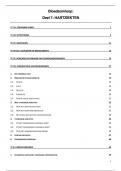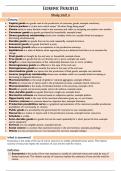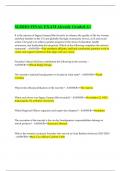Week 1, lecture 1 – Introduction
Everybody wants to get old but nobody wants to be old.
Why Healthy Ageing?
› Growing concern of ageing population and its societal consequences
› Often seen as a problem as considered to be related to worse health and high costs
› But also: Individual preference to age healthy
Life expectancies rise + fertility rates decrease.
Concerns related to ageing
› Old age related to sickness and disability-> assumption that rising life expectancy means more
medical conditions (Lecture 3, 6)
› Relative "imbalance" between younger and older age groups -> threat for sustainability of welfare
states and public finances (Lecture 13)
› Mobility of elderly, lurban planning (Lecture 11, 13)
Motivations for healthy ageing
› Societal, population or macro level motivation to cope with population ageing -> delaying disease
and disability, longer productivity and work lives, lower societal costs -> Are ageing populations really
a “time bomb”?
› Individual or micro level motivation to spend most years of life in good health, self-determined and
socially integrated -> How do we achieve that?
1
,Healthy Ageing – From populations to individuals
› Population ageing a macro level demographic phenomenon (macro level concerns groups of
people, societies as a whole, populations)
› Healthy ageing a micro level phenomenon (micro level concerns individuals, individual behavior and
outcomes)
› Healthy ageing leads to further population ageing
› Ageing society seeks to enhance healthy ageing
Productive, economy related.
Optimal, sociology related.
7 Facts on Healthy Ageing:
1. Normal ageing doesn’t exist
2. Taking hormons, vitamines, minerals doesn’t prevent ageing
3. There’s no limit to the human life span
4. The number of years without disability is increasing
5. The chance for older people to develop dementia will decrease
6. Older people rate their health with an 8
7. We are responsible for our later days
Health, ageing and the life course
› Healthy ageing determined by our behaviours over the life course -> life course is the
comprehensive view on the progression of life over age (lecture 5).
› Smoking, nutrition and physical exercise over the life course are core components of health at older
ages.
› also: social and physical environment play central role in healthy ageing -> intergenerational
support (lecture 8) and mobility (lecture 9).
Summary
› Healthy ageing a topic of great societal interest
• Societal focus -> cope with demographic challenges
• Individual focus -> more years in good health
› Often negative connotation to population ageing (“time bomb”) -> course will introduce to
population ageing and healthy ageing and discuss perceived threads.
2
,Week 1, lecture 2 - Rising life expectancy and population ageing
Life expectancy: general measure of all ages combined.
Biological limits to mortality, difficult/ not moral to test. In position to compare/ observe different
populations that occurred naturally. Maximum age that one individual can reach.
Ontogenescence = Decrease of death rates from birth to around age 10. Variations. Biggest influence
on life expectancy is what happens in the first years of life.
Senescence = Risk of death with age. Increase on exponential scale, linear line progression.
Accelerates at a constant rate, same percentage (not the same absolute number, like the interest
rate in bank account).
Gompertz law: risk of death = alpha * eB x
Alpha + Beta = two parameters
Alpha = intercept in straight line, mortality rate increases from one year to the next. Mortality rate at
birth.
Beta = rate of ageing/ increase, how much higher the risk of death will be next year compared to this
year. → Every year you chance of death increases with 0,1/10%, stable. Every year your risk of death
increases from the existence risk of death, 1/10.000, becomes 1,1/10.000 next year.
x = age
Mode, median, average.
Difference → Average is much more sensitive to outliers and extreme values. Die between 0-5 or
around 60. Average not a good measure if you have two extreme values.
What is the most frequent age of death? 85 (if ignored the first years of life and in western
countries), see picture below:
Dramatic increase in life expectancy is the result of the disappearance of infant mortality.
The mode is shifting.
Don’t overestimate the increase in life expectancy for adults, this is only around 20 years (70 to 90).
3
, NZ→ 90% migrants, in order to be a migrant you need to be in good health.
Two conclusions from above figure:
1. Record life expectancy has never decreased, it’s been increasing constantly in the last 170
years.
2. This increase has been linear.
Every year the record life expectancy increases by 3 months every year/ 15 minutes per hour we
spend.
4







